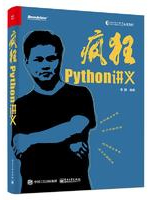《Python编程:从入门到实践》第五章:if语句
- 发布时间:
- 作者:码农之家原创
- 点击:847
Python编程:从入门到实践
这篇文章主要知识点是关于Python编程,从入门到实践,if语句,Python编程:从入门到实践,《Python编程:从入门到实践》第四章:操作列表 python编程学习np.float 被删除的问题解析 《Python编程:从入门到实践》课后习题及答案 《Python编程:从入门到实践》第六章:字典 python编程写代码时几个坏习惯总结 的内容,如果大家想对相关知识点有系统深入的学习,可以参阅以下电子书
5-1 条件测试
编写一系列条件测试;将每个测试以及你对其结果的预测和实际结果都打印出来。你编写的代码应类似于下面这样:
car = 'subaru'
print("Is car == 'subaru'? I predict True.")
print(car == 'subaru')
print("\nIs car == 'audi'? I predict False.")
print(car == 'audi')
详细研究实际结果,直到你明白了它为何为True 或False 。
创建至少10个测试,且其中结果分别为True 和False 的测试都至少有5个。
car ='subaru'
print("Is car == 'subarur'? I predict True.")
print(car == 'subaru')
print("\nIs car == 'audi'? I predict False")
print(car =='audi')
结果:
Is car == 'subarur'? I predict True. True Is car == 'audi'? I predict False False
5-3 外星人颜色 外星人颜色#1
假设在游戏中刚射杀了一个外星人,请创建一个名为alien_color 的变量,并将其设置为'green' 、'yellow' 或'red' 。
编写一条if 语句,检查外星人是否是绿色的;如果是,就打印一条消息,指出玩家获得了5个点。
编写这个程序的两个版本,在一个版本中上述测试通过了,而在另一个版本中未通过(未通过测试时没有输出)。
#Q1
print('Question one')
alien_color ='green'
if alien_color =='green':
print('you have won five point')
#Q2
print("\nQuestion two")
alien_color = 'red'
if alien_color == 'green':
print('you have won five point')
结果:
Question one you have won five point Question two
5-4 外星人颜色 外星人颜色#2
像练习5-3那样设置外星人的颜色,并编写一个if-else 结构。
如果外星人是绿色的,就打印一条消息,指出玩家因射杀该外星人获得了5个点。
如果外星人不是绿色的,就打印一条消息,指出玩家获得了10个点。
编写这个程序的两个版本,在一个版本中执行if 代码块,而在另一个版本中执行else 代码块。
print("Question one")
alien_color = 'green'
if alien_color == 'green':
print('you have won five point')
else:
print('you ha wo ten point')
print("\nQuestion two")
alien_color = 'red'
if alien_color == 'green':
print('you have won five point')
else:
print('you have wo ten point')
结果:
Question one you have won five point Question two you have wo ten point
5-5 外星人颜色 外星人颜色#3
将练习5-4中的if-else 结构改为if-elif-else 结构。
如果外星人是绿色的,就打印一条消息,指出玩家获得了5个点。
如果外星人是黄色的,就打印一条消息,指出玩家获得了10个点。
如果外星人是红色的,就打印一条消息,指出玩家获得了15个点。
编写这个程序的三个版本,它们分别在外星人为绿色、黄色和红色时打印一条消息。
print("Question one")
alien_color = 'green'
if alien_color == 'green':
print('you have won five point')
elif alien_color == 'yellow':
print('you have wo ten point')
elif alien_color=='red':
print('you have won fifteen point')
print("\nQuestion two")
alien_color = 'red'
if alien_color == 'green':
print('you have won five point')
elif alien_color == 'yellow':
print('you have wo ten point')
elif alien_color=='red':
print('you have won fifteen point')
print('\nQuestion three')
alien_color = 'red'
if alien_color == 'green':
print('you have won five point')
elif alien_color == 'yellow':
print('you have wo ten point')
elif alien_color=='red':
print('you have won fifteen point')
结果:
Question one you have won five point Question two you have won fifteen point Question three you have won fifteen point
5-6 人生的不同阶段
设置变量age 的值,再编写一个if-elif-else 结构,根据age 的值判断处于人生的哪个阶段。
如果一个人的年龄小于2岁,就打印一条消息,指出他是婴儿。
如果一个人的年龄为2(含)~4岁,就打印一条消息,指出他正蹒跚学步。
如果一个人的年龄为4(含)~13岁,就打印一条消息,指出他是儿童。
如果一个人的年龄为13(含)~20岁,就打印一条消息,指出他是青少年。
如果一个人的年龄为20(含)~65岁,就打印一条消息,指出他是成年人。
如果一个人的年龄超过65(含)岁,就打印一条消息,指出他是老年人。
age = 30
if age < 2:
print('It is a baby')
elif age >= 2 and age < 4:
print('It learns walking')
elif age >= 4 and age < 13:
print('he is a child')
elif age >= 13 and age < 20:
print('he is a teenager')
elif age >= 20 and age < 65:
print('he is an adult')
else:
print('he is a the old')
结果:
he is an adult
5-7 喜欢的水果
创建一个列表,其中包含你喜欢的水果,再编写一系列独立的if 语句,检查列表中是否包含特定的水果。
将该列表命名为favorite_fruits ,并在其中包含三种水果。
编写5条if 语句,每条都检查某种水果是否包含在列表中,如果包含在列表中,就打印一条消息,如“You really like bananas!”。
favorite_fruits = ['apple','banana','orange']
if 'orange' in favorite_fruits:
print('you really like orange')
if 'apple' in favorite_fruits:
print('you really like apple')
if 'banana' in favorite_fruits:
print('you really like banana')
if 'mango' in favorite_fruits:
print('you really like mango')
if 'pipeapple' in favorite_fruits:
print('you really like pipeapple')
结果:
you really like orange you really like apple you really like banana
5-8 以特殊方式跟管理员打招呼
创建一个至少包含5个用户名的列表,且其中一个用户名为'admin' 。想象你要编写代码,在每位用户登录网站后都打印一条问 候消息。遍历用户名列表,并向每位用户打印一条问候消息。
如果用户名为'admin' ,就打印一条特殊的问候消息,如“Hello admin, would you like to see a status report?”。
否则,打印一条普通的问候消息,如“Hello Eric, thank you for logging in again”。
users =['Nancy','Lucky','Tony','admin','Mary']
for user in users:
if user =='admin':
print("Hello admin,would you like to see a status report")
else:
print("Hello %s ,thank you for logging in again"%user)
结果:
Hello Nancy ,thank you for logging in again Hello Lucky ,thank you for logging in again Hello Tony ,thank you for logging in again Hello admin,would you like to see a status report Hello Mary ,thank you for logging in again
5-9 处理没有用户的情形
在为完成练习5-8编写的程序中,添加一条if 语句,检查用户名列表是否为空。
如果为空,就打印消息“We need to find some users!”。
删除列表中的所有用户名,确定将打印正确的消息。
users =['Nancy','Lucky','Tony','admin','Mary']
if users:
for user in users:
if user == 'admin':
print("Hello admin,would you like to see a status report")
else:
print("Hello %s ,thank you for logging in again"%user)
# users.remove(user)
else:
print('We need to find some users!')
users=[]
print("\n")
if users:
for user in users:
if user == 'admin':
print("Hello admin,would you like to see a status report")
else:
print("Hello %s ,thank you for logging in again"%user)
users.remove(user)
else:
print('We need to find some users!')
结果:
Hello Nancy ,thank you for logging in again Hello Lucky ,thank you for logging in again Hello Tony ,thank you for logging in again Hello admin,would you like to see a status report Hello Mary ,thank you for logging in again We need to find some users!
5-10 检查用户名
按下面的说明编写一个程序,模拟网站确保每位用户的用户名都独一无二的方式。
创建一个至少包含5个用户名的列表,并将其命名为current_users 。
再创建一个包含5个用户名的列表,将其命名为new_users ,并确保其中有一两个用户名也包含在列表current_users 中。
遍历列表new_users ,对于其中的每个用户名,都检查它是否已被使用。如果是这样,就打印一条消息,指出需要输入别的用户名;否则,打印一条消息,指 出这个用户名未被使用。 确保比较时不区分大消息;换句话说,如果用户名'John' 已被使用,应拒绝用户名'JOHN' 。
current_users =['Nancy','Lucky','Tony','admin','Mary']
new_user = ['Alice','Nancy']
for user in new_user:
if user in current_users or user.upper() in current_users or user.lower() in current_users or user.title() in current_users:
print('had been used,please enter another user name')
else:
print('not been used')
结果:
not been used had been used,please enter another user name
5-11 序数 序数
序数表示位置,如1st和2nd。大多数序数都以th结尾,只有1、2和3例外。
在一个列表中存储数字1~9。
遍历这个列表。
在循环中使用一个if-elif-else 结构,以打印每个数字对应的序数。输出内容应为1st 、2nd 、3rd 、4th 、5th 、6th 、7th 、8th 和9th ,但每个序 数都独占一行。
numbers = list(range(1,10))
for num in numbers :
if num == 1:
print('%dst'%num)
elif num == 2:
print('%dnd'%num)
elif num == 3:
print('%drd'%num)
else:
print('%dth'%num)
结果:
1st 2nd 3rd 4th 5th 6th 7th 8th 9th
《Python编程:从入门到实践》第十章:文件和异常
python编程的习惯整理
《Python编程:入门到实践》第七章:用户输入和while循环
《Python编程:从入门到实践》第六章:字典
18天学习《python编程:从入门到实践》心得笔记
以上就是本次给大家分享的全部知识点内容总结,大家还可以在下方相关文章里找到儿童python编程入门书籍推、 详解vue axios封装请求状态、 vue项目中使用md5加密以及、 等python文章进一步学习,感谢大家的阅读和支持。
展开 +
收起 -









